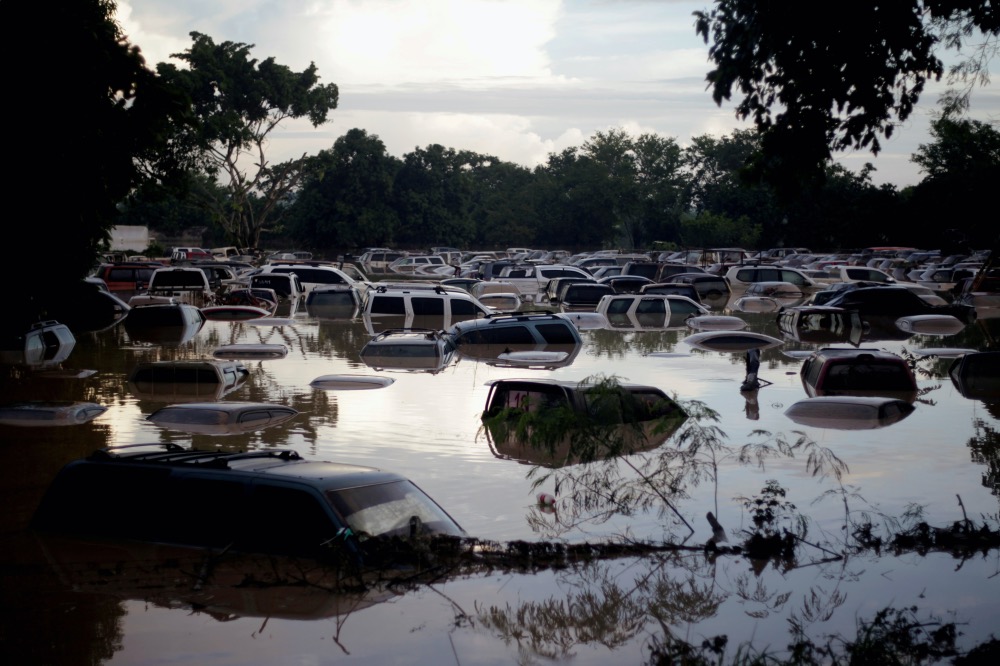Barcelona, Spain
Thomson Reuters Foundation
Spending to recover from the COVID-19 pandemic will determine whether countries are better able to adapt to more extreme weather and rising seas as the planet warms – a challenge they have failed to meet so far, top UN officials said this week.
In the fifth edition of its Adaptation Gap Report, the United Nations Environment Programme said some progress had been made on planning to protect economies and societies from the worsening impacts of climate change.

Vehicles are submerged at a plot flooded by the Chamelecon River due to heavy rain caused by Storm Iota, in La Lima, Honduras, on 19th November, 2020. PICTURE: Reuters/Jorge Cabrera/File Photo/File photo.
But not enough work had been done on the ground as funding fell far short of needs, with only an annual average of $US30 billion available for adaptation in 2017-2018, compared with an estimated requirement of about $US70 billion a year in developing countries alone.
UNEP Executive Director Inger Andersen said that, in 2020, floods, droughts and storms had affected 50 million people and wildfires had devastated forests and communities, even as countries struggled to deal with the pandemic.
“The only way to minimise these costs and damages is to race to adapt,” she said. “While we may be gathering pace, we are still losing this vital race.”
She and other leaders of UN agencies stressed that adaptation needed to happen in tandem with stepped-up efforts to reduce climate-heating emissions, as curbing global warming would lower the human and financial losses it causes.
But Petteri Taalas, head of the World Meteorological Organization, stressed that the heat-trapping carbon dioxide already in the atmosphere meant climate change impacts would continue until the 2060s even if emissions stopped rising now.
That signalled a “high need to adapt”, he added.
Poor nations are far less able than wealthier countries to cope with dangers like fiercer storms, he said.
Mozambique, for example, was not prepared to evacuate its people to storm shelters when Cyclone Idai hit in 2019, he said. That led to higher deaths and losses as a proportion of national GDP than when Hurricane Harvey battered Texas in 2017.
Adaptation includes a broad range of actions to keep people, buildings and the environment safe from climate extremes – from early warning of storms and heatwaves, to planting drought-resilient crops, and restoring mangroves and wetlands to reduce flooding.
The report said that, since 2006, nearly 400 adaptation projects supported by U.N.-linked funds had taken place in developing countries, and their size and financing was growing.
But of more than 1,700 adaptation initiatives surveyed, only 3% had so far reported real reductions to climate risks among communities, pointing to a lack of evidence on effectiveness.
The report focused on how so-called “nature-based solutions” – which conserve and restore ecosystems, such as forests and coastal reefs – are a low-cost way of helping countries adapt to climate change while bringing economic benefits to communities.
Warning signs
Andersen called on governments, as they prepare plans to recover from the coronavirus pandemic, to spend stimulus cash wisely to make infrastructure and people more resilient to accelerating climate change.
They should avoid investing in “grey infrastructure”, such as roads and concrete buildings, and favour measures like expanding green spaces in cities, she said.
“We will probably not have a situation [again] like the one we have right now, where we are seeing that amount of money going into economy – let’s not miss this chance,” she told journalists.
The UNEP report warned, however, that COVID-19 had pushed adaptation to climate change down the political agenda. Long-term, the economic downturn would put additional pressure on government finances and could weaken resolve on climate action, it said.
Patrick Verkooijen, CEO of the Global Centre on Adaptation, said an analysis by his organisation found that in national COVID-19 stimulus plans, dirty measures supporting high carbon emissions outnumbered green initiatives by four to one.
“Only a fraction of COVID spending so far is going to build climate resilience,” he said.
Developing nations faced even steeper adaptation funding challenges amid COVID-19, with climate impacts worsening even as budgets ran short and governments struggled to access financial markets, he added.
UNEP head Andersen backed a recent call by the UN Secretary-General for donor countries to agree before November’s COP26 climate summit to dedicate half of international climate finance to help poor nations adapt to global warming impacts.
Adaptation spending currently accounts for only about a fifth of climate finance allocated to developing countries.
UN climate chief Patricia Espinosa urged rich nations to urgently make up the longstanding shortfall in funding and asked all countries to produce specific national plans for adaptation.
Only about 25 have finished such plans so far, she said.
In terms of building climate resilience, “it’s like we are going into battle blindfolded with one arm tied behind our backs,” she said. “This is not how we achieve success.”





